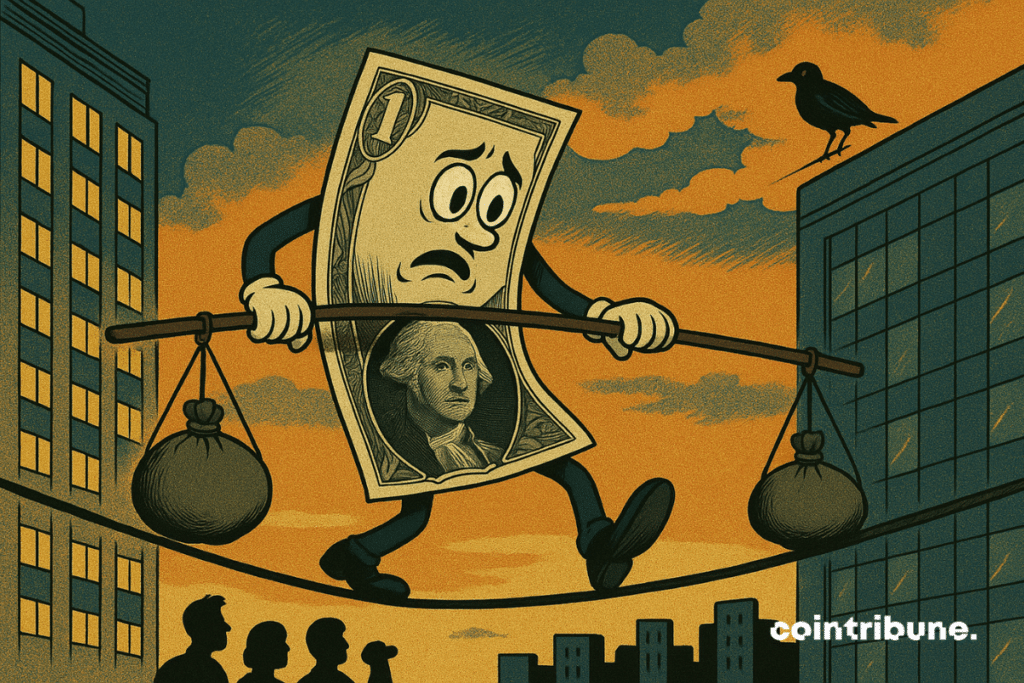Greenback Stumbles Yet Still Rules the Roost as Geopolitical Storms Rage
The dollar’s grip slips—but don’t expect any currency to dethrone the petrodollar’s bloodstained crown just yet.
Teflon resilience in a multipolar world
Despite inflation tantrums and de-dollarization theater from BRICS nations, USD still backs 58% of global trade (because nothing says ’stable reserve currency’ like printing $8 trillion during a pandemic).
Crypto’s opening shot
Bitcoin’s 15% monthly surge coincides perfectly with Argentina adopting BTC for contracts—a middle finger to IMF austerity that Wall Street’s still pretending is a ’niche experiment.’
The real test? When Texas oil starts trading for XRP—until then, enjoy the dollar’s ’weakness’ as it merely flexes from ’absurd’ to ’very strong’ dominance.

In Brief
- The dollar eased slightly after three weeks of gains, supported by a stronger-than-expected employment report.
- 177,000 jobs were created in April in the United States, a figure above expectations, reinforcing the Fed’s caution.
- China is reviewing a U.S. offer to revive tariff talks and could cooperate on the fentanyl issue.
- For cryptos, a strong dollar and cautious monetary policy keep pressure on prices.
A robust labor market that redefines monetary expectations
The latest U.S. employment figures exceeded analysts’ expectations. Indeed, the report published on Friday shows that 177,000 nonfarm jobs were created in April, compared to 130,000 expected.
At the same time, the March figure was revised downward from 228,000 to 185,000. This sustained strong pace in the labor market reassures monetary officials in their caution.
Jason Pride, Director of Investment Strategy Research at Glenmede, stated :
Today’s employment report probably allows the Fed to take a more patient approach regarding rate cuts this year.
He added that the central bank is trying to assess “whether the biggest risk is stagnation or inflation”, amid ongoing tariff pressures.
Markets have revised their monetary policy expectations, as shown by several key indicators observed after the data release :
- The probability of a rate cut in June has fallen to 35.6 %, down from 58 % the day before ;
- The futures market now only prices in three 25 basis point rate cuts by the end of the year, down from four previously ;
- The dollar, which had appreciated during the week, pared its gains after the release, while remaining on a weekly upward trend ;
- The euro closed the week down 0.5 % against the dollar, its largest weekly decline since mid-March.
This setup reinforces the idea that the Fed might not act before summer, extending a period of monetary wait-and-see. For crypto markets, this means that conditions for support through monetary easing, often a catalyst for increases, are not yet met. The dollar’s strength remains a pressure factor on risk assets, thus dampening upward market momentum.
Trade diplomacy revives market speculation
Alongside economic data, it was trade tensions and diplomatic signals that fueled dollar volatility late in the week. On Thursday evening, Secretary of State Marco Rubio indicated on Fox News that talks with China could resume soon.
This statement followed an opening signal from Beijing to resume negotiations. On Friday, China’s Ministry of Commerce confirmed it was evaluating a U.S. proposal aimed at restarting discussions on tariffs imposed in early April.
Moreover, China is considering measures regarding its responsibility in the fentanyl supply chain, in response to U.S. pressures. These elements helped bolster market optimism, which now anticipates a possible de-escalation.
On the international stage, Japan has also intensified dialogue with Washington. Negotiator Ryosei Akazawa reported deepening discussions with U.S. Treasury Secretary Scott Bessent on trade, non-tariff measures, and economic security topics.
Japanese Finance Minister Katsunobu Kato even mentioned the possibility of using Tokyo’s holdings of more than $1,000 billion in U.S. Treasury bonds as strategic leverage. These factors strengthen the hypothesis of a reconfiguration of trade power relations, with potential consequences for dollar stability and, by extension, global financial markets.
For cryptos, the implications are significant. On one hand, a dollar that strengthens based on a return of trade confidence may limit the appeal of these assets, seen as alternative safe havens. On the other hand, prospects for geopolitical normalization could restore market confidence, indirectly encouraging renewed risk appetite. However, activity data may remain strong for a few more months due to tariff anticipation, before a drop in spending and layoffs later this summer. If this scenario holds, volatility could return strongly to the crypto market as soon as the third quarter.
Maximize your Cointribune experience with our "Read to Earn" program! For every article you read, earn points and access exclusive rewards. Sign up now and start earning benefits.

